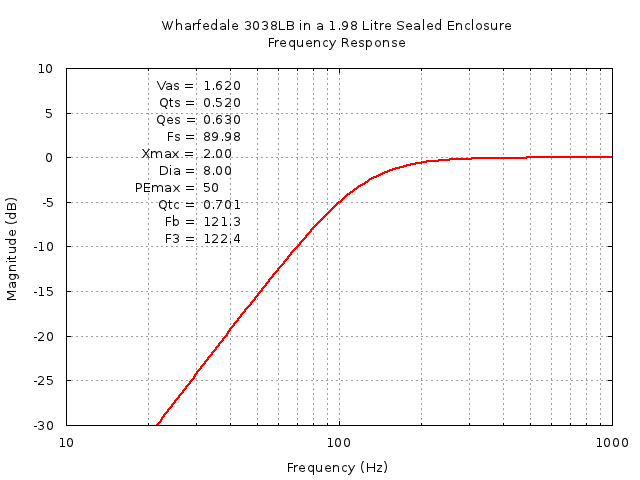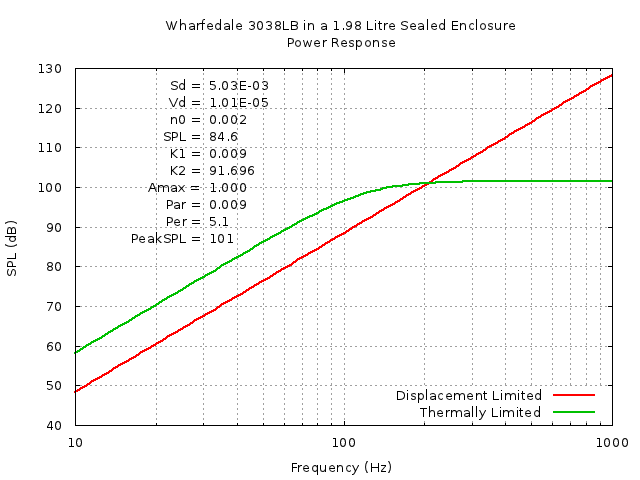Sealed
A sealed speaker enclosure has to be one of the simplest. As the name suggests, it comprises of a sealed box. There is lots of information available on the web for advice and guidance on building such an enclosure. However, I am going to keep things as simple as I can as this is going to be my first speaker build.
Calculations
The main source of information has been The Subwoofer DIY Page. It would have been simple to download the spreadsheet and work from that. However, just to make things a bit more complicated, the calculations were done with gnuplot.
This is not the place for a tutorial on Box Design or a detailed analysis of Thiele Small parameters. However, if you want to use gnuplot to help in your speaker design, then please click on one of the images to find the gnuplot script used. Some of the parameters have to be entered from the data sheet for the driver being used. For the ones not available, in the above example, a guess was made.
Box Design
The above calculations indicate that a sealed box for this driver needs to be about 1.98 litres in volume. That is a horrible number to work to. Therefore, the box will be designed for an internal volume of 2 litres. Some of this will be lost due to the space taken up by the driver. Final adjustments can be made by stuffing the box with sound absorbing materials, or solid lumps, as required.
With a design target of two litres, I need to add an allowance for the magnet. For the size of the driver, this will be quite large as the magnet is housed in a large can that acts as a magnetic shield. With a diameter of mm by mm long, I need to add litres to the internal volume of my box. This gives me a design volume of litres.
To reduce any chances of standing waves forming in the enclosure, the internal dimensions are related by the Golden Ratio.
So to achieve the desired size, with material thickness of 18.0 mm, the box will have to be as follows.
| Internal | External | |
| Width | 80.0 | 116.0 |
| Depth | 129.5 | 165.5 |
| Height | 209.6 | 245.6 |
As the speaker that I intend to use requires a 90 mm hole, the front baffle will have to be on the long side. Now with a little woodworking skill, all the panels could be cut at the external dimensions with 45° bevel edges to build a fully mitred box. Alternatively, a much simpler arrangement is to cut as follows, avoiding the more tricky mitre cutting and sticking to simple butt joints.
| Width | Length | |
| Front | 165.5 | 245.6 |
| Sides | 98.0 | 245.6 |
| Top & Bottom | 98.0 | 129.5 |
| Back | 129.5 | 209.6 |
These sizes can be used for a simple box. However, a better finish may be achieved if a lapped joint is used instead for the corners.
Construction
Although great plans were made for modelling the design and doing detailed drawings, my impatience got the better of me. A quantity of 18 mm thick MDF was to hand, and my saw was ready to go.
The panels were cut with hand held circular saw. A guide bar helped ensure the cuts were good and straight. The guide bar was used again with the router to ensure the edges were well finished and square. After forming the rebate, the panels looked something like this.

A bit of glue, drilling and routing later, the panels became a pair of finished speakers, like this.

OK, they are not quite finished yet. To improve their WAF, some stain will be applied to the MDF. Also, some damping material needs to be put inside the boxes. I do have some foam material that will by coincidence, be just the right size. I will stick that inside to start with, and then replace with some fibreglass insulation when I get my hands on some.
Conclusions
Well I am new to this, so I don't really understand what it is I am trying to describe. They do sound much better than expected. In fact, for a couple of drivers that cost less than a fiver each, the sound is very good. Although the bass is a bit lacking, as expected from the graphs, what is there sounds right. Vocals seem to be very clear. Almost a bit sharp. It will be interesting to see what a difference the damping material will make. These two speakers, coupled with a suitable sub woofer would make excellent computer speakers.
It will also be interesting to compare these with a vented box.

